History & Today – Facts and figures
Lithuanian nation has been forged by its history of seemingly eternal invasions, occupations and genocides, and a few long-remembered "glorious" periods inbetween.
Lithuanian society and social norms thus have strong influences from both East and West. However, there is always an undercurrent of free-thinking and independence. It is characterized (among other things) by respecting Lithuanian symbols and luminaries of ages gone-by.
Lithuanian politics and law tend to be especially complex as the usual leftist-rightist divisions are joined by many others related to views towards various periods of Lithuanian past.
Despite of this, Lithuanian economy has been improving nearly constantly since independence (and adoption of capitalism) in 1990. While 25 years were too little to close the gap behind the "First world", Lithuania already left the "Third world" far behind.
Because of its small size, Lithuania is still a rather little known country, however, giving rise to a number of myths about Lithuania, many of them considered insulting to Lithuanians.
See also: Maps of Lithuania.
Main facts about Lithuania
Population: ~3 000 000
Area: 65 300 sq. m
Population density: 46 inhabittants / sq. m
Altitude: Between -4 m and +294 m
Bordering countries: Russia (Southwest), Poland (South), Belarus (East), Latvia (North), Baltic Sea (West).
Ethnicities: Lithuanians 85,08%, Poles 6,65%, Russians 5,88%, Others 2,39%
Religions: Roman Catholic 85,9%, Russian Orthodox 4,6%, Other Christians 2,3%, religious non-Christians 0,7%, Irreligious 6,8%
Native languages: Lithuanian [official] 85%, Russian 8,2%, Polish 5,8%, Others 1%
Langauges spoken: Lithuanian [official] 96%, Russian 70%, English 30%, Polish 14%, German 8%
Historical periods: Grand Duchy of Lithuania until 1569, Polish-Lithuanian Commonwealth 1562-1795, Russian Empire 1775-1915, Republic of Lithuania 1918-1940, Soviet occupation 1940-1990, Republic of Lithuania 1990-
National holidays: February 16th, March 11th, July 6th
History of Lithuania: Introduction
First known habitation of Lithuania dates back to the final ice age, 10 000 BC. The hunter-gatherers were slowly replaced by farmers. The origin of Baltic tribes in the area is disputed but it probably dates to 2500 BC. These forefathers of Lithuanians were outside the main migration routes and thus are among the oldest European ethnicities to have settled in approximately the current area.
These Baltic peoples traded amber with Romans and then fought Vikings. In the era, only one small tribe from the area around Vilnius was known as Lithuanians but it was this tribe that consolidated the majority of other Baltic tribes. This process accelerated under king Mindaugas who became a Christian and received a crown from the Pope in 1253. After his death, the Grand Duchy of Lithuania fell back to pagan ways leading to a centuries-long conflict with Teutonic Knights.
The eventual adoption of Christianity by Grand Duke Jogaila (1387) did not stop the knights. Lithuanians forged a long-lasting alliance with Poland that eventually extinguished the Teutonic threat. Ruled by Grand Duke Vytautas Lithuania became the largest state in Europe, stretching from Baltic to the Black sea in the 15th century.


Battle of Žalgiris (Grunewald) by Jan Matejko. This vanquishing of the Teutonic knights is seen as the main medieval triumph of Poles and Lithuanians by romanticist historians. Streets and sports franchises are named after Žalgiris.
A new threat came from the east with Moscow rapidly gaining power and conquering lands. In response, Lithuania and Poland formed a Commonwealth in 1569. Initially, it was successful in deterring enemies. However, the political union led to gradual Polonization of the Lithuanian nobility as Lithuanians of the time regarded Polish culture to be superior.
By the 17th century, Poland-Lithuania was weakened due to a unique yet hard-to-manage political system of "Noble democracy" where a consensus was a prerequisite for any important decision. The Commonwealth lost a series of wars that wiped out its great power position. In the late 18th century (1772-1795) the country was completely partitioned and annexed by Prussia, Austria, and Russia with the main Lithuanian lands falling under the Russian rule.
The Russians banned Lithuanian language and suppressed Catholic religion. There were two unsuccessful revolts to restore Poland-Lithuania (1831 and 1863) but eventually the National Revival established a goal for Lithuania independent of both Russia and Poland. The restoration of statehood finally became possible after both the crumbling Russian Empire and the Germans surrendered in World War 1.
Limited industrial revolution and urbanization took place in late 19th century but the newly independent Lithuania was still an agricultural society. The short period of prosperous freedom was cut short again by the World War 2 (1940). Lithuania was occupied once by the Nazi Germany and twice by the Soviet Union, both powers perpetrating genocides. The brutal Soviet occupation lasted for 45 years and only ended in 1990. In this era hundreds of thousands of people, including the entire intellectual elite, were murdered, tortured or expelled to Siberia in cattle carriages. This has left deep economical, psychological and spiritual scars within the Lithuanian nation.
Guerilla campaigns of 1940s-1950s were crushed and any resistance persecuted but the massive Sąjūdis movement (established 1988) made it clear that not even the Soviet machine was able to suppress Lithuanian will for freedom. On 1990 March 11th Lithuania became the first Soviet-controlled country to restore independence and despite Soviet aggression in 1991 that left some 20 people dead, the independence was not reversed. In fact, it (amongst other reasons) led to the total collapse of the Soviet Union in late 1991.
In the 1990s Lithuania swiftly readopted capitalist economy and saw a massive economic growth, with modern skyscrapers, malls, detached homes, cars and renovated downtowns reaching Vilnius, Klaipėda, Kaunas and other cities, in that order. But the Soviet years left the economy decades behind that of the West. Disillusioned by unfulfilled hopes of getting rich quick many Lithuanians emigrated. This emigration reached epic proportions after Lithuania joined the European Union in 2004: the country lost up to 20% of its people to the newly accessible labor markets of the West.
See also: History of Vilnius, History of Kaunas, History of Klaipėda, History of Šiauliai, Ethnic relations history of Lithuania
Economy of Lithuania
The average Lithuanian is richer than 85% people in the world. He or she earns more than an average person in every nation of Africa, Latin America and most of the countries in Asia. However, Lithuania is lagging behind countries like those of Western Europe, the United States, Canada, Japan or Australia.


Countries richer than Lithuania (GNP per capita 2017) are green in this map while those poorer than Lithuania are red. ©Augustinas Žemaitis.
Among the member-states of the European Union and NATO Lithuania is one of the poorer countries. But it is richer than or on par with other Eastern European members of the said international organizations with the exception of the Czech Republic, Slovakia, and Slovenia.
Lithuania is a post-industrial society with some two-thirds of the population working in the service sector. The society is relatively egalitarian with healthcare, primary and secondary education being funded by the state. Undergraduate, graduate, and postgraduate education is also state-funded for the better students.
However, corruption is a major problem in the healthcare sector as many doctors expect bribes to be paid to them by patients so that they would receive preferential treatment. Corruption is rampant in other sections of the society as well, especially traffic police and government purchases (e.g. road construction for taxpayers' money). These practices are largely a legacy of the Soviet regime. However, Transparency International places Lithuania at some 50th place of 182 countries in its Corruption Perception Index (the higher the place - the less corruption there is), ahead of all states formerly behind the Iron Curtain save for Estonia and Poland (but far behind the West, Japan or Australia).
The largest employer in Lithuania is the MAXIMA group that owns a chain of retail shops well visible in Lithuania as well as Latvia, Estonia, and Bulgaria. This is the largest company in Lithuania and its owner Nerijus Numavičius is the country‘s richest person. Just like many Lithuanian businesses MAXIMA is primarily owned by a single person (or a single family) rather than being a publically traded company.
Largest industries in Lithuania are oil refinement (Mažeikių Nafta in Mažeikiai; 36,2% of total 2011 exports) and fertilizer manufacturing (Lifosa in Kėdainiai and Achema in Jonava; 8,9% of exports). Processed and unprocessed food amount for 16,9% of exports. Traditionally strong clothing industry has been hit by outsourcing to Asia.
The agricultural sector now employs only some 12 percent of the population but they are good at lobbying. Therefore the government generally subsidizes agriculture. The European Union adds to this although the European Union subsidies are significantly lower than for farmers in countries like France. Typically Lithuanian farmers grow grain, pigs, chicken, and cows. The "traditional agriculture" where a family owns a single cow, a single pig and some pastures (rather than combining land to form a large business) is declining but still well entrenched in the Lithuanian countryside. Village tourism offers a new opportunity for Lithuanian farmers and tourists alike.
Symbols of Lithuania (Anthem, Flag, Coat of Arms)
Lithuanian coat of arms, known as the Vytis, depicts a mounted soldier with raised sword on a red field. Dating back to the Grand Duchy of Lithuania it is among the Europe's oldest emblems. Atypically its source is Grand duke's seal rather than a dynastic coat of arms.
As the Grand Duchy spanned far beyond modern Lithuania the Vytis inspired many other symbols. Between 1991 and 1994 it (in a slightly different form) served as the coat of arms of Belarus and it is also included in some municipal and regional coats of arms in Poland.
A flag with Vytis had also been used in the Grand Duchy. Today it is designated "Historic flag" and is increasingly used alongside (or even instead of) the national flag in many places.
The modern Lithuanian national flag is a 20th-century creation. As the reestablished Lithuanian state (1918) was a republic a tricolor design was adopted. Since the French Revolution (1789) most European republics used similar flags.


Lithuanian coat of arms (left) and the tricolor flag (right).
Lithuanian anthem "Tautiška giesmė" (National hymn) has been created in 1898 by Vincas Kudirka, one of the heroes of Lithuanian National Revival (adopted in 1920). It is notable for having each verse to follow a different melody and therefore should never be shortened (trimming the anthem in some sports events triggers discontent). A peculiar tradition calls every Lithuanian to sing the anthem on July 6th.
| Tautiška giesmė by Vincas Kudirka Lietuva, Tėvyne mūsų, Tegul Tavo vaikai eina Tegul saulė Lietuvoj Tegul meilė Lietuvos |
National hymn English translation ©Augustinas Žemaitis. Lithuania, our homeland, May your children follow May the sun over Lithuania May the love of Lithuania |
Other symbols strongly associated with Lithuania are the Columns of Gediminas (or Pillars of Gediminas) and the Cross of Vytis (a.k.a. Cross of Jogaila), both named after medieval Lithuanian rulers. They are repeatedly used in many other symbols. For instance, Cross of Vytis forms a part of Lithuanian Coat of Arms and the air force ensign whereas the Pillars of Gediminas were used for the trademark of Eurobasket 2011 event held in Lithuania and political party symbols.
In Dzūkija where there is a strong presence of Polish speakers ethnic Lithuanians traditionally erect crosses of Vytis instead of traditional crosses in churchyards and roadsides to signify their ethnicity.


Cross of Vytis and Pillars of Gediminas in their typical forms (left) and their modern uses: a churchyard cross of Vytis in Dzūkija and the Pillars of Gediminas as architectural elements in Kaunas (on the Officer's club and a bridge). ©Augustinas Žemaitis.
Other things and practices held as "national" by significant parts of society (none of these - except for language - are enshrined in law so that's purely traditional):
National bird: White stork (ciconia ciconia)
National tree: Oak
National flower: Rue
National language: Lithuanian
National religion: Roman Catholicism
National sport: Basketball
National meal: Cepelinai (a.k.a. Didžkukuliai)
National alcoholic beverage: Beer
National "mineral" (jewelry): Amber
National musical instrument: Kanklės
National saints: St. Casimir and St. George
Bird/tree/flower are based on their prevalence in folklore. Sport/religion/language are the most popular ones, followed by the majority of the population. Meal/beverage/mineral/musical instrument are based on popular opinion. Saints are recognized by the Catholic church.
A band in national clothes performs folk music. Lithuanian folk costume consists of plain white elements and colorful patterns (stripes, tiles, etc.) and cover all the body except for palms and head. Women wear skirts and men wear trousers. Currently, the national clothes are used only in folk art performances, historical re-enactments and (by some people) during national holidays. ©Augustinas Žemaitis.
Common abbreviations (country codes) for Lithuania are LT and LTU.
As Lithuania became a member state of the European Union and NATO, the European Union flag is waving near nearly every Lithuanian government institution or embassy next to the Lithuanian flag, while the NATO flag is waving at some institutions.
Flags as they appear in the main hall of the Lithuanian government. Lithuanian and European Union flags stand side-by-side while the table hosts the flags of all the member states. ©Augustinas Žemaitis.
Traditional Lithuanian wooden cross and Rūpintojėlis (a sculpture of a sad Jesus) have also become symbols of Lithuania, especially in the Lithuanian communities abroad where many Lithuanian churches and even secular buildings have such symbols erected in front of them.
Old crosses at Zervynos village. ©Augustinas Žemaitis.
Maps of Lithuania
Demographic maps
Ethnic map of Lithuania
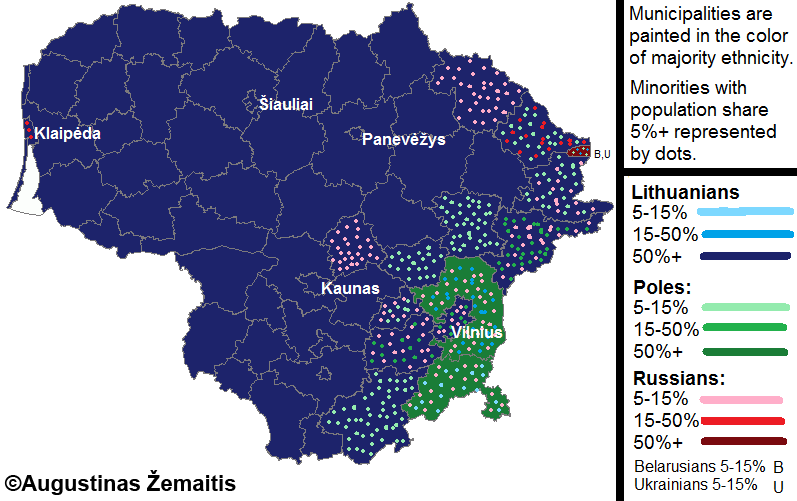

Ethnic map of Lithuania. The minorities are largely concentrated in the east. ©Augustinas Žemaitis.
See also: Ethnicities in Lithuania
Religious maps of Lithuania
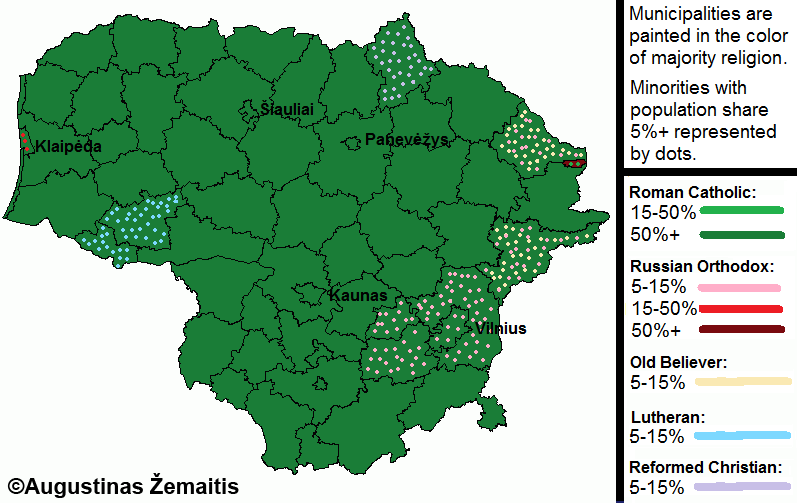

Map of Lithuanian religious communities. In most municipalities 90%+ people are Roman Catholic. Significant religious minorities are concentrated in particular areas. ©Augustinas Žemaitis.
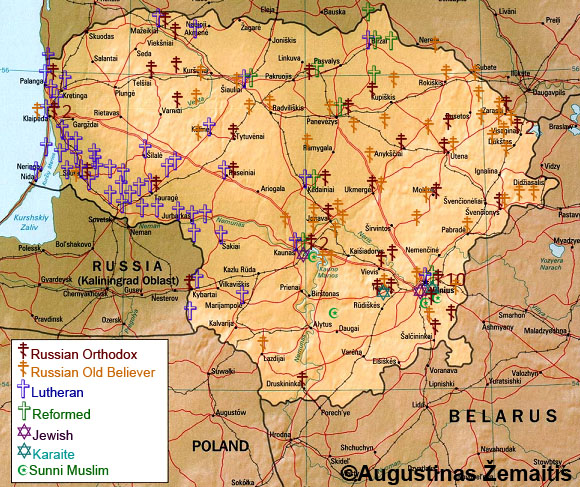

Map of religious minority houses of worship in Lithuania. ©Augustinas Žemaitis.
See also: Religions in Lithuania
Transportation maps
Lithuania road distance map


Lithuanian road network scheme with distances in kilometers marked. ©Augustinas Žemaitis.
More info: Getting around Lithuania
Lithuania passenger rail map
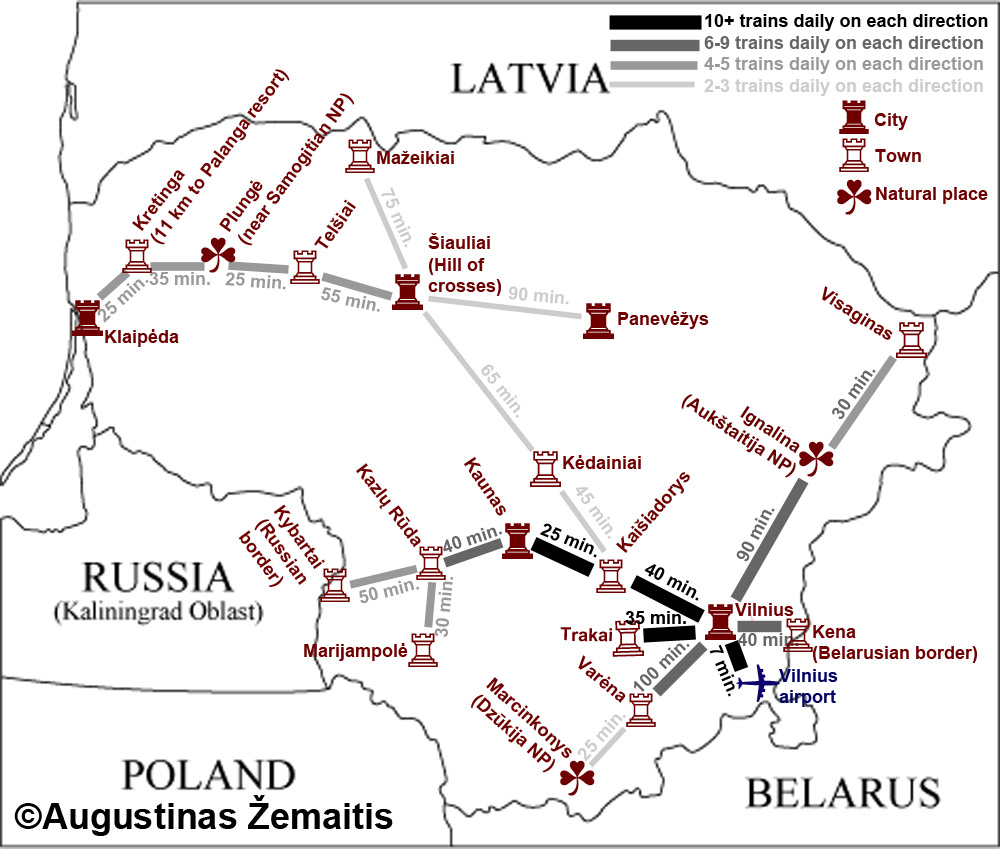

Lithuanian passenger railway services scheme with times necessary to get between stations marked. The times are approximate but fast and slow trains in Lithuania do not deviate that much from each other, so you shouldn't expect the real travel time to be more than 20% longer or shorter than specified here. The train routes are normally quite long (100-400 km) so you would not need to change trains if going in one direction. This map is extensive, however, a few less-than-daily and suburban routes are not marked. ©Augustinas Žemaitis.
More info: Getting around Lithuania
Lithuania air routes map


A map of available air routes and frequencies from Lithuania and the most popular ways to transfer further on.
More info: Getting to and from Lithuania
Political and economic maps
Countries richer and poorer than Lithuania
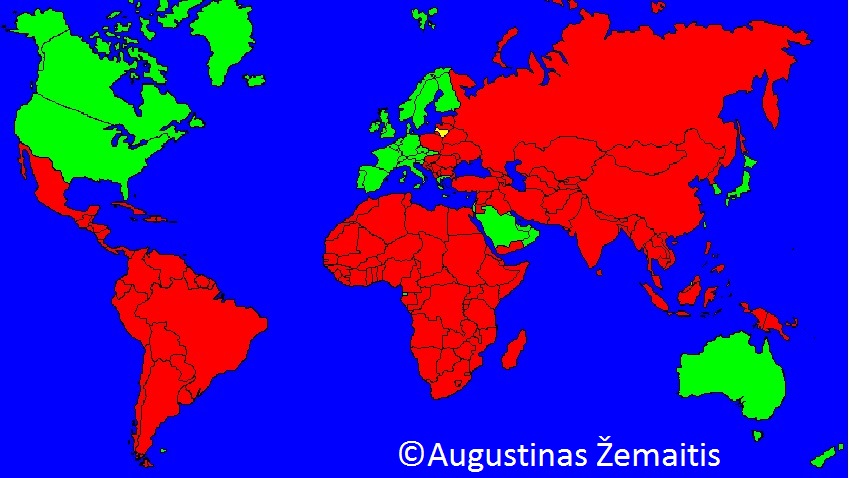

Countries richer than Lithuania (GNP per capita 2013) are green in this map while those poorer than Lithuania are red. ©Augustinas Žemaitis.
More info: Economy of Lithuania
Map of Lithuanian visa policy


Citizens of the green countries do not need visa to Lithuania.
Citizens of the red countries need a Lithuanian visa.
Citizens of light green countries do not need visa if they have biometric passports.
2013. ©Augustinas Žemaitis.
More info: Lithuanian Visas and Entry Requirements
Historical maps
Map of Grand Duchy of Lithuania expansion (13th-15th centuries)
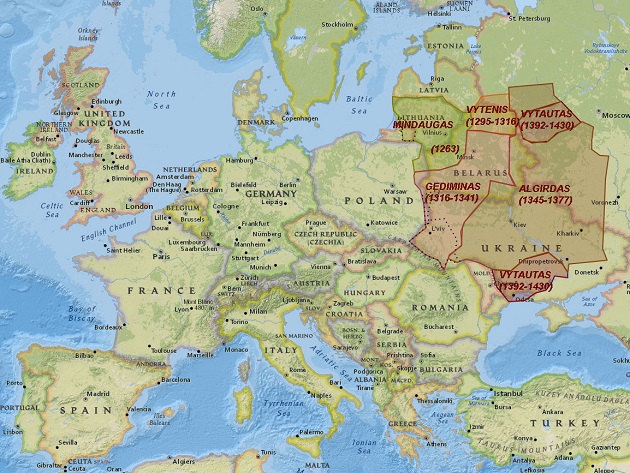

Establishment an expansion of the Grand Duchy of Lithuania, superimposed on modern European state boundaries. The areas enclosed by black dotted lines indicates regions both acquired and lost before 1430. ©Augustinas Žemaitis.
More info: Grand Duchy of Lithuania (until 1569)
Map of Polish-Lithuanian Commonwealth at its largest extent (~1630)
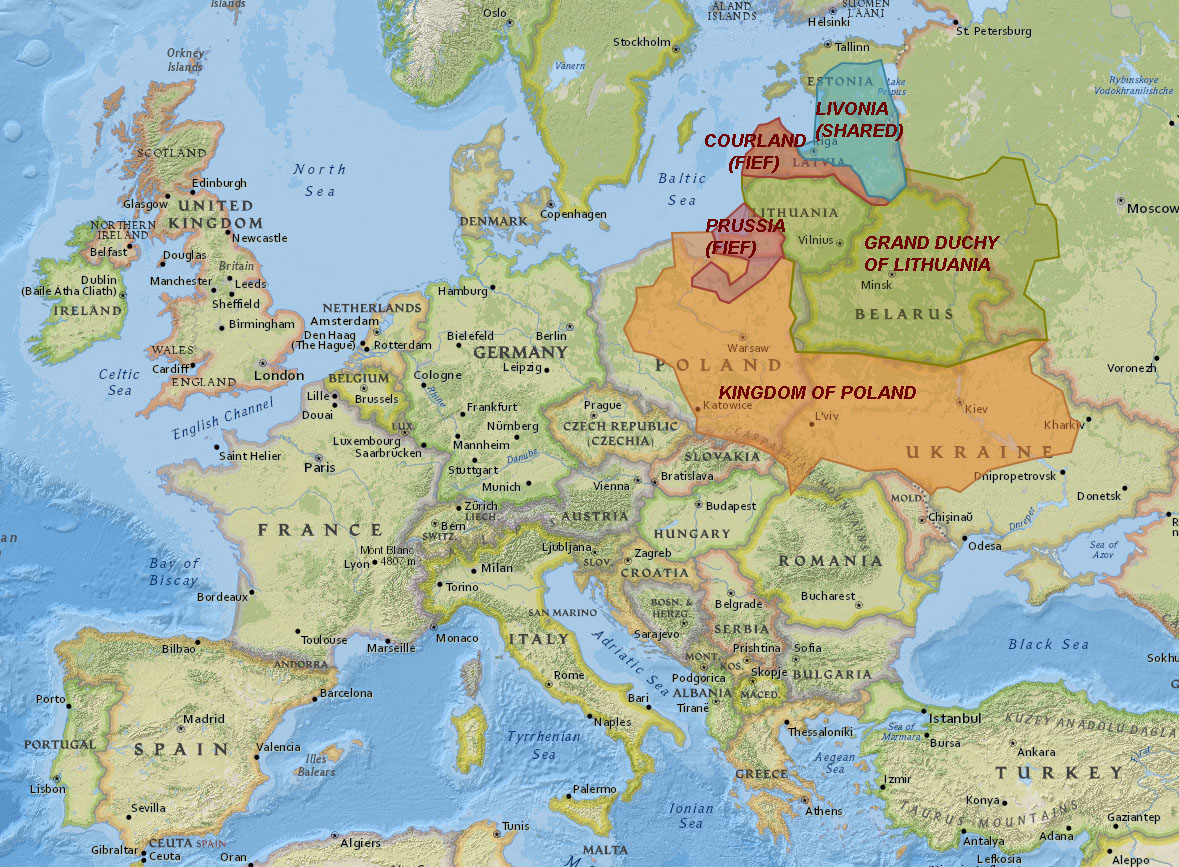

Polish-Lithuanian Commonwealth at its highest territorial extent (1616-1657) superimposed on modern European state boundaries. ©Augustinas Žemaitis.
More info: Polish-Lithuanian Commonwealth (1569-1795)
Map of Lithuanian National Revival (19th century)


Simplified map of the ethnic-linguistic situation of Lithuania ~1900. It could not depict the mixed areas, numerous ethno-linguistic enclaves, diglossia and dual identities that prevailed alongside ethno-linguistic boundaries. ©Augustinas Žemaitis.
More info: The rule of Russian Empire in Lithuania (1795-1918)
Map of Interwar Lithuania (1920s-1930s)
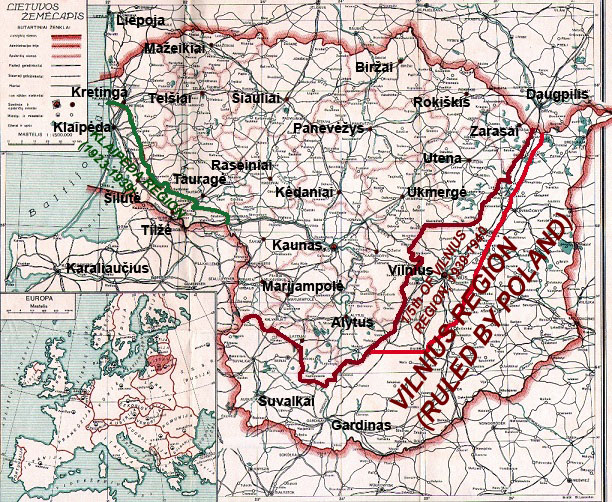

A map of interwar Lithuania with some new information for clarity. Klaipėda region and Vilnius region are marked.
More info: Interwar independent Lithuania
Decline of Lithuanian language (200-1990 AD)


The decline of Lithuanian language and other Baltic languages over the centuries, stemmed by Lithuanian and Latvian national revivals and independence. ©Augustinas Žemaitis.
More info: Lithuanian language
Politics in Lithuania: Introduction
Lithuania is a democratic country since 1990. Its directly elected president may be its best known and most popular politician, but the real power is vested in Seimas (parliament) and the government. Lithuania is a unitary country, its municipalities controlling only minor local affairs.
Ideologically Lithuania is divided along several lines: leftist vs. rightist economic viewpoints; pro-Western vs. pro-Local vs. pro-Eastern value systems; authoritarian vs. libertarian opinions about personal freedoms. Moreover, a significant part of locals proudly lacks an opinion on these matters and claims to be "apolitical".
Lithuanian political parties range from "ideological" ones contesting every election (the Homeland Union, Socialdemocrats, Liberals) to sometimes ephemeral "personal" ones created, merged and folded at will by famous star politicians whose names become eponymous to such parties.
Lithuanian foreign policy aims to integrate with Western Europe into a tight European Union and keep friendly relations with USA (the "leader of NATO"). Much of this is to repulse Russia, seen as a threat because of the occupations and Genocide it perpetrated. Lithuania also seeks to consolidate Central and Eastern Europe, help the region (and itself) become completely independent of Russia and more Western-oriented. Lithuanian military is aimed to help Western allies in their battles elsewhere to secure their help should Lithuania be attacked.
Lithuanian law is largely modeled after that of continental Central Europe, although it differs on some key matters.
The tax system in Lithuania is characterized by a relatively high tax burden, especially labor taxes.
Foreign Relations of Lithuania
The foreign relations of Lithuania since the restoration of independence may be summed up in a sentence: “To leave the East and to (re)join the West”. However, the true situation is somewhat more complicated and not as stable.
In the early 1990s, Lithuania passionately broke ties with the former Soviet regime. It eagerly adopted capitalism and one of the few successful referendums ever (due to very strict referendum laws) requested Russia to compensate damages of the occupation. With the rise of Vladimir Putin in Russia (1999) the aims of restoring justice stalled as Russia failed to try the Soviet war criminals who murdered Lithuanians, attempted to whitewash the Soviet Genocide and refused to compensate its victims.
Initially summed up by the neologism “Euroatlantic integration” the Lithuania’s alignment to the west divulged into pro-European and pro-US stances as the agendas of the former Cold War allies separated. Under former US citizen president Valdas Adamkus (1998-2009) Lithuania was staunchly pro-American but later drifted to a more and more pro-European stance.
Plaques on Vilnius City Hall mark the city's World Heritage status (2002) and cites G. W. Bush speech he said to a crowd here during his 2002 visit to a pro-American Lithuania. ©Augustinas Žemaitis.
Lithuanian relations with the neighbors varies. While cordial with Latvia and Estonia, the Lithuanian-Polish relations are frequently marred by the issues of Polish minority in Lithuania and the Lithuanian minority in Poland. Despite this, Poland remains a close ally of Lithuania, unlike Belarus. Lithuania harbors emigrant opposition against the Belarusian president Alexander Lukashenko, popularly known in Lithuania as the “Last dictator of Europe”. Belarus, similarly to Russia and Israel, has failed to try the people who participated in the Soviet Genocide of Lithuanians.
Under president V. Adamkus Lithuania supported the pro-democracy rallies in post-Soviet countries like Georgia and Ukraine. Remarkable relations with Georgia were developed and Lithuania positioned itself as the bridge between the Europe's East and West. Under the president Grybauskaitė (2009) this was initially supplanted by a so-called “pragmatic policy” that evaluated other countries by their economic importance rather than democracy record. The hopes that this would improve economy were left unfulfilled. Not surprising, knowing that Lithuania’s GNP per capita surpasses that of every single pro-Russian post-Soviet country, in some cases by 500%. After the Russian invasion of Ukraine in 2014, Lithuania re-adopted a policy more critical of Russia.
Būtingė oil terminal, one of several massive Lithuanian projects to ensure the energetic independence. Before the terminal was built, the only way for Lithuania to acquire oil was via a pipe from Russia, that would have been regularly shut by the Russians for political reasons. ©Augustinas Žemaitis.
Regardless of political leanings, most politicians support the goal of "energetic independence", which means costly projects to connect Lithuanian gas, power and other networks to Western Europe. For decades, many networks were integrated into the ex-Soviet system, making Russia a nearly-monopolist supplier able to sell at above-market rates as a form of political pressure.
Relations with other countries than named here are negligible, but Lithuania maintains embassies in Japan, Egypt, South Africa and the People’s Republic of China for economic ties.
Law of Lithuania
Lithuania has a Roman legal system based on laws. Legal precedents are subordinate to laws but also recognized. Laws are drafted and adopted by the Parliament. Other institutions (including municipalities) may adopt bylaws which could not contradict the laws.
Laws of Lithuania
Nearly every law and bylaw in Lithuania has been adopted post-1990 as the country completely reversed its course after dropping the Soviet shackles. Much of the legal system has been modeled on various long-standing laws of Western European countries as the pre-occupation (1940) Lithuanian laws were deemed too dated to reinstate.
The Constitution has been adopted by referendum in 1992.
There is no single Lithuanian Code in a way there is a US Code. Instead, there are multiple codes for different spheres of law, the most important of them are the Civil Code (includes commercial law), Criminal Code, Civil Procedure Code, Criminal Procedure Code, Administrative Penalties Code and the Labour Code.
There are also many shorter laws that govern particular areas which are not covered by the Codes. For example, in the intellectual property sphere, there are separate laws for patents, trademarks, copyright/related rights, plant breeds, topographies, and designs.
Sometimes the same issues are governed by several laws in which case the least abstract one typically holds precedence.
After Lithuania joined European Union (2004) it has to adopt certain European Union-wide measures. These are set in the EU treaties (which are applicable directly), EU directives (which must be incorporated into Lithuanian laws to become fully applicable) and EU regulations (applicable directly). If the EU measures conflict with Lithuanian laws typically the EU measures apply.
Lithuanian judicial system
In Lithuania, there are two systems of courts.
Criminal and civil cases are heard by the Common courts of which there are three instances. 49 district (apylinkės) courts are the first instance for minor cases. The district court decisions may be appealed to five county (apygardos) courts which also serve as the courts of first instance for major cases. These major cases may then be appealed to the single Appellate Court (Apeliacinis teismas). And finally, there is the Supreme Court (Aukščiausiasis teismas) which is the third (cassation) instance for all cases.
The second court system is that of Administrative courts (administracinis teismas) which solve disputes against administrative (usually governmental/municipal) institutions. There are two instances: regional administrative courts and the Highest Administrative court (Vyriausiasis administracinis teismas) the later hosting appeals.
The Constitution is safeguarded by Constitutional court the decisions of which are largely political and have been criticized for limiting democracy when popular opinion oppose that of the establishment. Whenever some court or other major institution thinks a law might be in breach of Constitution it applies to the Constitutional Court for an answer.
In a similar fashion, European Court of Justice in Luxembourg may be addressed to explain the European Union law.
In addition to courts, there are prejudicial institutions which are in some cases voluntary, in others a required step in dispute resolution.
The litigation time in Lithuania largely depends on the case and varies greatly. Arbitrage may be stipulated in contracts but it is not popular even in business spheres.
See also: Lithuanian laws on major issues, Lithuanian ethics, virtues, and morale
Famous Lithuanians: Introduction
Just like every nation, Lithuanians have certain national heroes who have many streets and institutions named after them, who were depicted on banknotes and are immortalized in statues. This is a short introduction to the stories that are hidden behind the names you will undoubtedly see frequently while in Lithuania.
The earliest and some of the best-known figures are the largely pagan Lithuanian leaders of 13th-16th centuries who made Lithuania the Europe's largest country. That mighty Grand Duchy eroded over the centuries and was completely destroyed by Russian invasion in 1795 however. Therefore the 19th century National Revival is another era where many famous Lithuanians hail from (almost all Litas banknotes have their faces on the obverse).
Other groups well represented in street names include artists, writers and other wise men of Lithuania Minor, writers and artists of the early 20th century, heroes of interwar independent Lithuania and controversially some Soviet writers. Religious (Christian) and mythological figures are also represented.
Modern Lithuanian celebrities (post 1990) are not yet honored by street names but they dominate newspapers, magazines, and TV shows.
Take note that Lithuanian is a synthetic language, therefore the final letters of a name are written differently when that name appears different contexts. For instance, a street named after Grand Duke Gediminas would be called “Gedimino” (nominative case).
Myths about Lithuania – introduction
Regular foreigners, foreign media, foreign politicians, and even foreign researchers often encounter and unwillingly spread some misconceptions about Lithuania.
Some of the misconceptions about Lithuania have their roots in subtle language and cultural differences, others come either from biased sources of information (e.g. Soviet propaganda) or superficial sources of information (e.g. TV shows), and yet others might have been true in the past but are no longer so. All of them tend to get repeated even by many reputable people, therefore it is often impossible to discover that something is a myth just by checking your sources.
Here we have collected the top myths about Lithuania foreigners often have. We try to also analyze how each of these myths came into being.
Note: many of these myths may be insulting to Lithuanians or even regarded to be a manifestation of anti-Lithuanian hatred. Therefore, if you have Lithuanian friends or business contacts, please avoid mentioning them.
Broadly, the key misconceptions about Lithuania can be grouped into four categories, ranging from the least insulting to the most insulting:
1.The myths that Lithuania is a worse place to be than it really is - that it is extremely poor, unsafe. These myths do not take into account the progress Lithuania made since the Soviet occupation ended but may be seen as a genuine faux-pas since the progress has been too fast for the public opinions to go in line with it.
2.The myths that Lithuania is a new country/nation which previously was Russian, Polish, Belarusian or that Lithuanians are similar to the Russians. In reality, Lithuania was the medieval Europe's biggest country and Lithuanians as a culture developed in this land long before most other European cultures (~4000 years ago). People who perpetuate these myths may be seen as ignorant by Lithuanians but not necessarily malevolent as these myths are usually repeated simply due to oversimplification of history.
3.The myths that incorrectly or superficially explain the Lithuanian culture and language arriving at various wrong conclusions. The most prevalent among those is the myth that Lithuanians are unwilling to consider minorities as Lithuanian but the myth about racist Lithuanians often also has roots in incorrect interpretations of Lithuanian culture. While believing such myths may arguably be somewhat acceptable for tourists, the fact that there are some foreigners who live in Lithuania for many years and yet continue to repeat these myths baffles and deeply saddens many Lithuanians. The long-term believers of such myths may be seen as being either ignorant, prejudiced or having a cultural superiority complex.
4.The blatant or indirect denial of the occupations, persecutions, and genocides suffered by Lithuanians in the 20th century or portrayals of the Lithuanian victims as responsible for their own fate or even for the fate of others. These myths (most of them originating in Soviet propaganda) claim that either Lithuania has joined the Soviet Union willingly, that Lithuanians were communists, that Soviet Union has liberated Lithuania and was better than Nazi Germany or that Soviet rule in Lithuania had many bright sides. Interestingly, there are other (just as insulting) myths that claim exactly the opposite: that Lithuania supported the Nazi Germany, that Lithuanians were or even are Nazis. These myths are not only seen as extremely insulting by Lithuanians but also as dangerous, as similar myths have been used by Russia in order to denigrate the statehoods of Lithuania and other Central/Eastern European countries and promote wars against them.
Moreover, in a separate article, we explore the 6 different approaches to Lithuanian historiography based on the standpoints of 6 different ethnic groups. One-sided interpretations of historical events often give rise or support to myths about Lithuania.
Ethnic relations in Lithuania (introduction)
History of Lithuania is often presented in very different lights depending on whoever writes it. There are numerous "positions" on various issues, quite often correlating with the ethnicity, religion and/or nationality of the author.
The reason for this is that for different groups of Lithuania's people each period tend to bring extremely different prospects. At the same time some groups prevailed, others were persecuted or even murdered en masse (and vice-versa). Naturally (often perhaps subconsciously), a person from a particular group, even if he is a historian, tends to put more emphasis on his or her own group, consider their losses to be more tragic, their own mistakes to be less grave, and their own victories to be more glorious.
This article aims to present all the standpoints on the history of Lithuania and the reasons why they exist by explaining the ethnic relations in Lithuania in every period of its turbulent history. The article is grouped by periods, and then by pairs of ethnicities.
First, however, we present a rough scheme of Lithuanian history which shows what was the situation for each group during each historical period, ranging from 1 (which means genocide) to 9 (which means domination beyond the borders of modern-day Lithuania). This diagram is capable of explaining differing opinions on various eras.
Of course, this diagram is a simplification: the reality was more complex, with each group subdivided into many sub-groups which also often faced different issues.
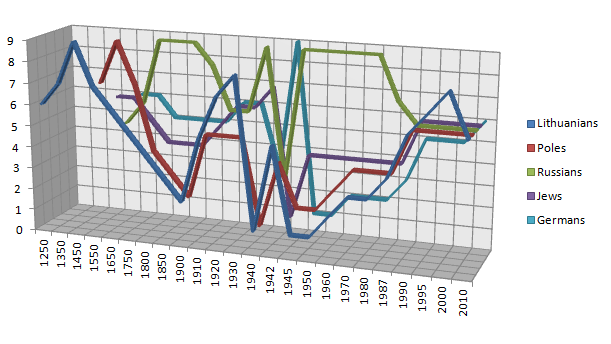

Diagram of the position of the ethnicities in Lithuania in different years. 1 - genocide, 2 - heavy persecution, 3 - medium persecution, 4 - low status (but little ethnic persecution), 5 - mediocre status, 6 - high status (but no cultural domination), 7 - threatened domination in Lithuania, 8 - undisputed domination in Lithuania, 9 - domination beyond the area of modern-day Lithuania. ©Augustinas Žemaitis.


